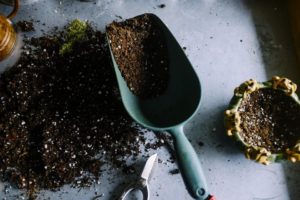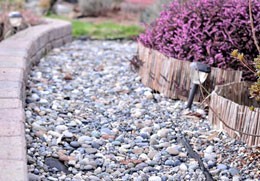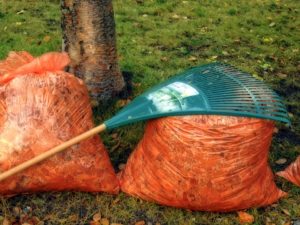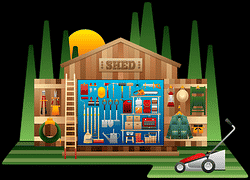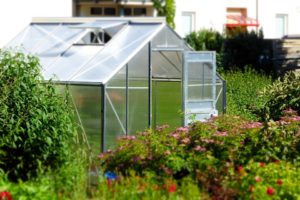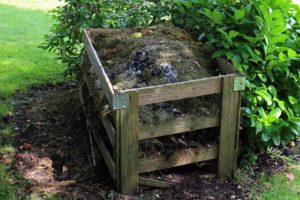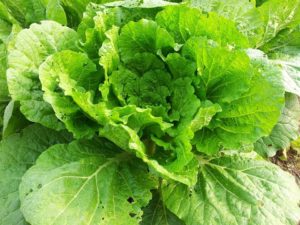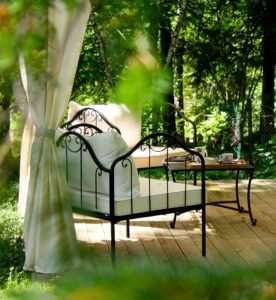Choosing Plants for Your Garden with Spring in Mind
Spring is the best time to dust off your gardening boots and step back out into the outdoors after the long winter break. It is most gardeners’ favourite time of year as it brings a chance of a new start. At Madingley Mulch in Cambridge we are enjoying the longer days spring offers, and we have a wide variety of gardening and landscaping products for you to enjoy too.
This includes top-quality soil conditioner products, such as our own unique blend Denise’s Delight which can be added to your soil now, before planting starts, to improve your topsoil and give your plants and seedlings the best start in life.
Once you have conditioned your soil, then it is time to start planning which varieties of flowers you want to grow, to brighten up the garden. You can choose annuals to flower this year or biennials which will give you flowers this year and next. Perhaps you are thinking of perennials which will return year after year – bigger and better than the year before! Or if you want a low maintenance garden then maybe you are thinking of shrubs to fill your tubs. Here is a guide to growing this spring.
Flowers to Plant in Springtime
If you are planning on having some summer hanging baskets, or are looking for something to fill your beds and borders, then you cannot go wrong with some busy lizzies. They are really good value, and are so easy to grow, so that even a novice gardener can enjoy plenty of blooms from these brightly coloured plants. Another great value flower is geraniums. They come in just about every shade, and the lemon and apricot varieties are the most popular flower on the market at the moment. Plant both these at the end of March or beginning of April and they will flower right through until the end of the summer.
A favourite for your patio pots are petunias, another spring planting flower which can fill containers for months. All you need to do to get them to re-flower is to do a little dead heading, where you remove any old flowers by nipping them off, and you will see new blooms appearing almost immediately.
If you have a lot of garden to fill, then in April plant some ground cover solutions such as creeping phlox. They form a layer of green foliage and above that a bright-coloured carpet which can suppress weeds, and because they flower right through to the first frosts of winter you can enjoy them for months without a break.
Shrubs for Spring and Summer
For a garden which needs a little less maintenance than one full of flowers, it is a good idea to introduce some shrubs in mid-spring, around April time. Cornus alba is a hardy shrub and can stay outside all year round. It is a lovely green-leafed plant which can be added to a pot for a statement piece, or you can use it as a hedge. Another good-looking shrub is the forsythia, which pretty much grows anywhere and is planted in June. It has little yellow flowers in springtime and really adds colour when little else is showing through.
Hedging is becoming more popular than ever, mainly because of the huge range of different types you can get. Shrubs are perfect for filling empty spaces in dark corners of the garden, and some types can offer security too, such as red leaf rose, an attractive dense thicket which is loved by wildlife. Plant it out at the end of March, giving it time to adjust before summer comes.
Fuchsias are some of the prettiest shrubs available, and can be planted as early as March. They flower from June right through to September and sometimes even into October. These multi-coloured plants can be added to baskets, containers or borders, making them ideal for filling spaces all over the garden. They have even been used on garden tabletops.
Garden-Ready Plants
If you have missed the March-April planting window, do not worry, because many horticulturalists and garden centres offer a garden-ready version of many of the above plants. They are bigger than the plug plants offered in March and do not need to be grown-on, so they can be planted straight outside in the garden and will be ready to flower almost immediately. These garden-ready plants are perfect for those who do not have a greenhouse or have busy lifestyles. You will also find that there are lots of collections available which will have a variety of flowers, such as alliums, lupins and berberis, so you can fill your garden fairly cheaply and get a display that will be hard to beat next year.
At Madingley Mulch in Cambridge we have a huge selection of plant care products, such as soil conditioner, topsoil, compost, mulch, soil improver, lawn dressing and our own blends of Denise’s Delight and Tony’s Tonic, both of which have essential nutrients for all your garden and allotment plants. We offer free delivery in the Cambridge area and supply customers from a wide surrounding area, including Bedfordshire, Hertfordshire, Essex and Suffolk. We run a regular delivery service to destinations including Huntingdon, Saffron Walden and Newmarket, and this is free to all addresses within 15 miles of our base. To find out more follow the link.
How Can You Improve Your Soil for the Growing Season?
Once winter has disappeared, and spring is on its way, gardeners everywhere are itching to get back outside. One of the first jobs growers do is to check the condition of the earth they will be cultivating their crops and flowers in. At Madingley Mulch in Cambridge we supply a variety of soil improver products, including our own blends, Tony’s Tonic and Denise’s Delight, which will boost your topsoil by adding valuable nutrition.
How Soil Improvers Can Help Your Garden
When the earth is uncultivated, and untouched then there is no need to rally it, as this is done by the plants themselves, with rotting plant matter and animal waste going back into the earth. However, once the ground has been used to raise crops or flowers, then there is a need to further enhance it with vital nutrients and organic matter.
Soil improvement and soil conditioning products contain organic matter and plant food, which all plants need, but some plants in particular need a fertiliser to get the best out of them. These types of enhancers can be used to enrich structure and fertility, increase plant growth and plant yields. Organic matter can also be used as a weed suppressant. It is quite easy to see if your earth needs a pick-up, as it will dry out in summer and your plants will not develop very well.
Different Types of Soil and Ways to Improve Them
Most soils in the East of England have a very small proportion of organic matter, less than in the rest of the country. Clay soil is the main type in the East, and is high on the ph balance scale, with a high alkaline content. This can be hard on your plants, as clay is heavy, very sticky and quite hard to work with. It is made up of lots of tiny mineral particles which reduce the space for air to circulate – which means the ground will retain water and become more compacted. You can tell your soil has a high clay content if you can mould it in your hands!
If your beds and borders go quite hard in the summer, then this is another indication that the earth is full of clay, which will bake and crack on the surface. These soils are very fertile but need help to unlock the nutrients in them. To change the make-up of clay, you can use a 6mm horticultural grit. This will help the soil to break up, increasing the air circulation and drainage capacity, and making it easier to add compost to your garden.
Silt soil has bigger particles than clay and drains easier, and is smoother to the touch and doesn’t hold its shape as well as clay does. A sandy soil has the largest particles and is much more free-draining, due to the air spaces between particles being larger. If the soil is light and gritty, cannot be moulded in the hands and has poor fertility, then you have a sandy soil. This type needs the most improvement, as the nutrients can just be washed away.
Which Crops Are Enriched by a Soil Improver?
All crops will benefit from soil enrichment, but there are some which will need more help. When growing vegetables, improving the soil is very important, as the crop produced is in direct relation to the quality of the ground it is grown in. A spent mushroom compost will restore the health, structure, boost drainage and aeration of heavy clay soils. Root crops such as carrots, swedes, turnips, onions and garlic will all have larger yields and better quality vegetables if the ground is nourished in this way.
Seedlings will need lower nutrient levels and higher phosphate, as this helps to create a strong root structure. This type of organic matter has a finer texture which the roots can grow into. If the earth is too hard or particles too large, then the roots will not be able to develop.
Madingley Mulch’s soil conditioner is perfect for your beds and borders, as it contains essential nutrients for the ground and also has a plant food already added. This will increase the number of flowers growing, and will also enhance longevity and the size of the blooms.
When you are trying to develop the earth in your garden for growing grass,, a lawn dressing is the ideal solution. This product has a loam blend, which includes peat and sharp sand. It is used to correct the topsoil quality and feed the roots of your grass, and is fine to use whether you are laying turf or growing your lawn from seed, as this product will encourage both.
Madingley Mulch
Madingley Mulch are quality suppliers of all your gardening and landscaping needs in East Anglia, including Cambridgeshire, Bedfordshire, and Essex. We have an excellent range of soil improvers, including Denise’s Delight, which is half made up of well-rotted horse manure and half of Black Fen soil, composts and topsoil. For more information or to arrange delivery, contact Madingley Mulch or visit our shop to see our wide range of products.
Enhance Your Garden with a New Hedge
Are you thinking of adding a new hedge to your garden or commercial site in Essex, Cambridgeshire or the surrounding areas? The benefits are more privacy, a more distinct boundary marker, security and the attractiveness of a well-maintained hedge full of leaves and berries. Garden mulch suppliers Madingley Mulch have put together some tips to help you decide which hedge is best for your needs.
A New Boundary
Hedges are natural boundary makers, and the decision of whether you want a security hedge or a decorative one – or a combination of both – is down to personal choice. Before planting, you will need to make sure the ground is prepared first. This means adding a quality compost, such as mushroom compost, and soil improver to the ground before planting, especially if the soil is poor.
Also recommended is to add garden mulch when the hedge is planted, although you need to be careful not to let it touch the stem as this will weaken it and disease could set in. Mulching will help retain moisture in the soil, and an organic mulch can improve the soil’s fertility as it decomposes.
Pruning
Your new hedge will need to be maintained, and can be trimmed in a variety of ways. When it is best to prune depends on the type of hedge. As well as being garden mulch suppliers, we stock a good selection of garden tools, including those from the Spear & Jackson range. When considering pruning, it is important to remember in springtime you must check there are no birds nesting in the bushes, as disturbing them is an offence under the 1981 Wildlife and Countryside Act.
Colourful Options
If you are looking for a decorative hedge, remember that not all of them are plain and green, although an evergreen such as holly will give more privacy all year round if this is what you require. A floral hedge such as hawthorn has small white blooms during summer, which makes an attractive border and is perfect for encouraging wildlife and birds.
Copper beech hedging has glorious deep purple leaves during summer, providing a dramatic focal point. If you are in a hurry, privet hedges are fast-growing and are quick to provide a boundary solution; and ramanas rose will grow in almost any conditions and is a great deterrent fence with its spikes and thorns.
Coastal Areas
For those who live in a coastal area of Essex, Cambridgeshire or Suffolk, hedging is also a good choice, with the New Zealand Broadleaf being a safe bet. It is a fast-growing, easy to manage hedge which is happy in sandy soil and works well as a wind breaker protecting your garden. For an attractive hedge, Field Maple has gorgeous golden leaves providing interest in the garden during autumn, and its winged seeds are loved by animals and birds alike.
Fencing
If you decide a hedge is not for you and you would prefer a fence, of if you’d like both for different sections of your garden, we have all the products and tools you will need, including fence panels in a variety of styles, fence posts and fence post mix and cement.
Whether you have chosen a fence or hedge, both will benefit from a layer of mulch from Madingley Mulch. This will help to suppress any weeds around your hedge or fence, stopping your boundaries from being overgrown. You can speak to our experts in store about all the products needed for a new fence in your garden in the Cambridge and Essex areas.
Tips for Planning a Vegetable Garden
If you’re new to gardening, it can be difficult to know where to begin when planning a vegetable plot. From deciding where to locate the veg patch and choosing what to plant to knowing how to fertilise it with mulching or mushroom compost, gardeners have a lot to consider when planning a new, productive part of their garden.
Madingley Mulch are one of the most trusted gardening and compost suppliers in the East of England, serving customers in Cambridge, Essex, Suffolk and the surrounding areas. To help you create a fertile and fruitful vegetable garden or allotment, we’re taking a look at some of the key aspects of preparation, planting and care for the growing veg.
Preparing the Soil
The first step in creating a brand new vegetable garden is clearing the area. You’ll need to remove the grass, get rid of the weeds and pick out as many stones as you can. Once you’ve cleared the area, you’ll need to dig it over to aerate the soil and prepare it for planting. At this stage, it’s a good idea to dig in compost, mulch or other elements that will enrich the soil and help your veggies to thrive.
In areas where you have heavy clay soil, which is the case in many parts of Essex and Cambridgeshire, organic matter like mushroom compost, Black Fen soil, manure or soil conditioner will help to add nutrients and improve its structure. If you’re unsure which type of soil improver is right for your garden, ask one of our expert team for advice before you buy.
Sowing Your Crops
Once you’ve done the hard work of preparing the soil and clearing the area, the fun can begin. If you’ve decided to grow your vegetables from seed, you can now start ordering in your stock. Remember that different plants grow better in different conditions, so take the sun exposure, soil type and water level of your vegetable patch into account when ordering your seed supplies.
In sunny vegetable gardens that are sheltered by fence panels or nearby trees, broad beans and peas can be sown out. If you have a greenhouse or covered area, herbs, salad leaves, celery and potatoes can be sown in pots ready to plant out when the weather warms up.
Cucumbers, tomatoes, leeks and aubergines can all be started in the greenhouse, while beetroot, carrots and radishes can be grown in a cold frame and raspberry canes, strawberry plants, blackcurrants and gooseberries can all be planted straight into the veg patch.
Care for Growing Plants
In order to get great results from your vegetable garden, you need to care for it regularly throughout the growing season. You’ll have to keep weeds to a minimum to avoid valuable nutrients being stolen away from your veggies. This can be done by pulling weeds out by hand, but you can also prevent them growing in the first place by mulching the ground in between your vegetables. This mulch will also help to protect your vegetables from unexpected bad weather.
You’ll also need to ensure your vegetables get plenty to drink, especially during periods of dry or hot weather. As different crops require different levels of hydration, it’s important to check each plant’s requirements before you get the hose out. In the winter months, when the rain seems almost endless, extra watering probably won’t be necessary. Keep an eye on water levels to make sure your plants are getting enough, and consider giving them a little extra food during cold snaps to keep them strong.
If you’re planning a vegetable patch and searching for soil improvers, mulch, compost or any other gardening supplies in Cambridge, Suffolk or nearby areas, Madingley Mulch can help. Click above to find out more.
Paving Slabs – Perfect for Patios and Pathways
To enhance the quality and appeal of your home, imagine how a new patio or path would look in the garden. If you already have these, but they look worn out, renewing them could improve the exterior of your house and add value to it too. At Madingley Mulch in Cambridge, we have a range of paving slabs to help you create a stunning feature in your outdoor space, which will last for many years.
So, how do you go about choosing where to place your new patio, or pathway – and what sort of pattern is best suited to your home?
Choosing the place
To choose the best stones, we recommend searching for the right colour and texture to suit your exterior. When you are ready to choose a new patio, check what its uses will be – for eating your meals or sunbathing? If it is mainly intended for socialising and taking meals, then it is a good idea to place it near the back door of the kitchen or dining area.
When you are deciding on the size, if you already have some garden furniture, check its size to see how much space you will need. This will indicate how many paving stones are needed, and the amount of room you will be required to leave for a comfortable gap around the patio set. If your terrace is for sunbathing, then plan to lay it where you will get the most sunshine during the day!
When adding a pathway to your backyard, think about where you want your path to go and the function of it. For a long, narrow space, a straight path will look great down the side of the house and shrubbery. It will offer a space to walk on, to place a washing line next to, or frame the border plants. However, if your back garden is large, and square, you could plan your footpath to meander around the beds and borders, separating them from ornamental structures and specimen displays. This will highlight those features and make the route an essential link to the different sections of the lawn.
Along with your patio or path, you can also create a small number of steps with flagging stones, which will create another interesting feature. To do this, start by making an outline with an aerosol to see where the path fits the best, and then you will be sure to know where the best position for your footpath is.
What type of design
There are plenty of different designs to choose from when adding pathways and patios to your outside area. If you have a traditional house and would like to continue with this style, our Courtyard Paving stones in Old Grey would be a perfect match, with their weathered look of centuries old stone masonry.
For a superior quality stone, which is straight sided for easy use, you could choose Premier Riven Slabs. These are ideal if you need a quick solution to your path and patio needs, with four different shades to choose from to match your colour scheme.
If your home is made from light-coloured bricks, then the natural finish of Rutland Oakham is ideally suited. It has a high-profile riven surface and includes dressed edges, which can be linked together to cover any plot, so they are ideal for driveways and large patio surfaces. A corner kit is also available if you want to finish off the project. Modern homes often need slightly different paving slabs to complement them, and our Textured Paving is a hard-wearing stone with a flecked pattern. This non-slip surface is good for playgrounds too, and, with three different colours, there will be one to match or contrast your exterior building.
Edging
Edges come in different sizes and shapes, so choosing the right one is down to preference. For a natural finish, you can leave the grass to slowly grow over the edges of the pathway, reducing straight lines throughout the lawn and allowing nature to take its course. But if you would like a modern, clean-lined space then our Scallop Topped edging will have a huge impact. You can edge paths and patios in either Round Top edging or Scallop Topped, as both look good against the backdrop of your floral borders and bedding. The traditional edging Terracotta Rope is an elegant edge for paths – bringing back the pre-war style which has been so sought after recently.
Finishing Touches
Adding finishing touches to your patio can be fun. Choosing planters of spring flowers and containers of evergreens will add interest through summer and winter. This will enhance the colours and textures around the courtyard. You can also hang solar lanterns along the path with lighting draped around the trees, which will brighten up and give character to your newly designed outdoor space.
Decorative stones, sharp sand and grout to use for the completion of your patio and pathway are all available at Madingley Mulch. Based in Cambridge, we have many customers from Essex, Suffolk and Bedfordshire. If you have any queries or would like more information on our paving slab range, click here to contact us.
Top Tips to Create an Attractive Garden Path
Not only will an attractive path add style and character to your property, but it will also improve access to your outside space, helping you make the most of your garden. Madingley Mulch offers a great range of specially designed products that will enhance the look and usability of any garden path. From decorative stones and paving slab to bark mulch, we have all the supplies you need to transform gardens in Essex, Cambridgeshire and the surrounding areas.
Whether you’re looking to create an entirely new path to take the pressure off of your lawn or you just want to give an existing path a makeover, we can help. Here are our top tips for creating a stylish and useful garden path.
Dividing the Space
Whatever style of path you opt for, the design will delineate your garden and create distinct areas. If you’re adding a new pathway to the space, it’s important you think about how you’re going to use your garden and how you want the area to be divided. Look at any ‘desire paths’ that have naturally been created in your garden, where people regularly walk through. This will show you how you and your family use the space and will help to inform your path design.
Selecting Surfaces
The surface you select for your new garden path will have a big impact on its finished look. One of the most popular surfaces is gravel. Not only does gravel look great, but it can also help to improve drainage both within the soil and around pipes and drains. Choose standard gravel for a classic look or opt for white or gold gravel or round stones for a more contemporary appearance.
Another option for your path’s surface is decorative stone chippings. Offering similar drainage benefits to gravel, stone chippings are an economical and stylish way to create a garden path. You can select from light-coloured Cotswold chip, sophisticated charcoal stone, Staffordshire pink or even red granite for your new garden look.
Homeowners who want to add a feel of permanence to their outside space should select solid paving slabs for their garden path surface. Rustic slabs like our Rutland Oakham stones or our Courtyard Paving design are ideal for those looking for a traditional finish
Alternatively, for a more natural look, opt for a mulch surface. Affordable, easy to walk on and ideal for homeowners who want their new path to blend in with their garden, this organic surface comes in a range of colours and sizes. If you live in Essex and are looking for a nearby supplier of bark mulch, we have one of the best selections around, making it easy for you to find the perfect surface for your new path.
Edging
If you want a natural, informal garden look, let your path merge gently into your lawn. Alternatively, for a cleaner aesthetic, install edging and give your path a defined finish. Stone edging can be used with a range of surfaces or you can opt for large pebbles, cobbles or stylish slate chippings to complete your new outside area.
Finishing Touches
As well as edging, your new garden path will look great finished off with appropriate lighting. Solar lights will add a welcoming touch to your new path after dark, helping you navigate your garden and making a real feature in your outside space. You could also consider planting shrubs, flowers and even small trees along the length of your path to give it increased definition and divide up your garden.
If you’re planning on giving your garden a facelift this winter, Madingley Mulch stocks a wide range of materials for paths, patios and all outside spaces. All of our products are available from our shop which is visited by many customers from across Essex, Suffolk and East Anglia. To make your garden makeover as easy as possible, we can deliver supplies to homes in a 15-mile radius of our site in Cambridge.
To find out more, or to start planning a garden path of your own, explore the product range at Madingley Mulch.
How Can You Turn Your Garden into a Winter Wonderland?
If you’re a keen gardener, winter can seem like one of the year’s saddest seasons. Bare trees, frozen earth and hibernating plants can make a garden look drab and lifeless, especially if you’ve planned your planting around summer flowers. However, with some advice from garden mulch suppliers Madingley Mulch, you don’t have to suffer through winter without any colour to cheer up your Essex, Cambridgeshire or Suffolk garden. With a bit of planning and a touch of imagination, you can breathe life into your garden even in the coldest, darkest months of the year.
To help you achieve the cold weather look you want, here are some top tips for how to bring a touch of sunshine to your outside space when the mercury plunges. These ideas will help brighten up your home’s exterior until spring rolls round again. You can also give a festive touch to your garden during December, and we have a great range of Christmas trees at the Madingley Mulch shop.
Winter Colour
The most natural way to introduce colour to your winter garden is to plant bright, bold flowers and shrubs around the space. Add a festive splash of red to your planting scheme with beautiful Heavenly Bamboo or striking Scarlet Willow. Or, if you have a wooded area, plant some Red-barked Dogwood. Unremarkable in the summer months, this stylish plant comes into its own when its leaves fall and the bright red of its new stalks is revealed.
For a lush, summery look, opt for some fragrant herbs and shrubs like rosemary, lavender, thyme, sage and juniper. Not only will these plants help your garden to smell wonderful, but you can also use them to add flavour to your festive cooking this winter. If you need to improve the soil in your Essex garden ready for planting, or want to keep weeds to a minimum around your new evergreen additions, as garden mulch suppliers we will be able to provide you with bark mulch for your outside space.
Conifers
Conifers are fantastic for bringing winter colour to your outdoor space. If your garden is bijou or you don’t want to block out light to your home, slow growing conifers like Berrima Gold, Minima Aurea and Nana are ideal. Alternatively, opt for classic conifers like Norway Spruce or Rheingold to add a sculptural element to your landscaping.
If you don’t want to wait years for your conifers to grow to size, you can invest in potted plants and create instant impact. Place potted conifers in rows alongside your garden path or on your patio to enhance your outdoor area and emphasise its features.
Hard Landscaping
Hard landscaping is a very effective way to brighten up an outside space. Painted fencing panels can bring colour to your garden year round, while a new garden path or patio can help to add character and definition to your lawn. If you are going to install a new path or patio, opt for bright materials like Indian paving slabs, red granite stone chippings or Staffordshire pink pebbles to really brighten up the space.
A Touch of Christmas
Christmas is a great excuse to add colour and sparkle to your garden. Festive lights, holly garlands and decorated trees will all help to fill your garden with Christmas cheer and brighten up your home’s exterior. For a longer-term solution, plant a few holly bushes or conifers in your back or front garden. Then you can use spotlights, string lights or solar lights to turn them into features when the holiday season rolls around.
To start planning your winter garden makeover, explore the choice of products on the Madingley Mulch site . We are based in Cambridge and supply customers in areas including Essex, Suffolk and Hertfordshire. Or why not visit our shop to choose from our Christmas trees and other products?
Two Low Maintenance Garden Ideas
Large lawns and elaborate flower beds look beautiful, but they can be difficult to maintain if you don’t have the time to spend on your garden. If you lead a busy lifestyle, rent out your property, or are physically unable to keep on top of tough gardening tasks, then it might be time to think about creating a low maintenance garden. Fortunately, simple can still mean stunning and there are plenty of design ideas for gardens that require minimal upkeep. Madingley Mulch, who supply bags of gravel, mulch, decorative stones and sand to customers in Bedfordshire, Cambridgeshire and Suffolk, bring you two low maintenance garden ideas to help you create the perfect outdoor space in time for spring.
The Zen Garden
Zen Gardens have been popular in Japan for centuries and promote peace and tranquillity. They can incorporate gravel, rocks, pebbles, sculptures and/or water features to transform even the smallest of outdoor spaces into a place of beauty. Whether you live in the town or countryside, it will provide a relaxing retreat to unwind in after a busy day.
This type of garden benefits from being low cost, low maintenance and provides an outdoor space for meditation and quiet thought. Often found in Buddhist Monasteries, Zen gardens generally have a gravelled area that represents the ocean, which the monks will rake over and over again to relax their mind as they trace the patterns of the waves. If you are planning on having a gravelled area, it is advisable to take the lead from the monks and mark out the waves with a wooden rake; you won’t get the same effect with metal prongs. You will need to rake the gravel fairly frequently as it can get knocked out of shape on windy days or during heavy rainfall. Artfully placed stones, as in the picture above, will create a focal point.
For best results, map out your Zen garden first to help you decide what you want to include and where. Be as imaginative as you like with this space. Some gardeners like to incorporate a water feature, such as fountain or a long, rectangular pond containing Koi carp. For the more adventurous, a small, curved bridge running across the centre of the pond looks pretty and will provide a place of contemplation. Another option is to include an element of surprise, such as a seated area concealed beneath a wooden archway, or a shaped lawn with a Buddha in the centre. This is particularly effective in country properties that have more than one garden, or a garden that is separated into different sections or zones.
The Paved Garden
The origins of this style of garden goes back centuries when the space was used for outdoor cooking. In the Roman era, householders used to have courtyard gardens with either a fountain or a well in the centre to catch rainwater. Fast forward to the 21st century and the paved garden is a popular choice for those who don’t have time to mow the lawn or tend to the flower beds. It is also ideal for gardens with limited space.
If you are opting for a paved garden, the first step is to decide on what type of paving slabs to use. At Madingley Mulch we have a full range of paving slabs in all colours, to create the ideal courtyard style garden. These include Rutland Oakham for a rustic look, Indian Sandstone, Textured Paving or Premier Riven Slabs for a more contemporary appearance and old grey Courtyard Paving for a romantic, traditional look.
You’ll also need to work out what to include in your garden. You may want to go for a minimalist look, with a gravel or coloured stone border and a focal point, such as a water feature or sculpture, in the centre. Another option is to include a bench or picnic table and to have planters containing vibrant blooms to add colour. If you are planning on doing lots of outdoor entertaining in the warmer months, a brick-built barbecue or pizza oven, along with comfy cushioned seating, might be the best option for this space.
About Madingley Mulch
Madingley Mulch provide outdoor garden supplies including bags of gravel, paving slabs, sand, decorative stones, cobbles and chippings to customers within easy reach of our Cambridgeshire based shop. Click on the link above to buy.
6 Tasks to Prepare Your Garden for Winter
Gardening is a year round job as your lawn and plants still need care and attention, even in the coldest months of the year. November is the time to safeguard your plants from frost, clear the leaves and prune trees, so that you can keep up the appearance of your outdoor space. Unsure where to start? Here are six priority tasks from Madingley Mulch, who supply high quality gardening products, including lawn top dressing, to customers in Bedfordshire, Cambridgeshire, Suffolk and Essex.
Clearing the Leaves
A top task before the onset of winter is to clear the leaves off your lawn. This keeps your lawn neat and tidy, prevents mould and ensures your lawn can ‘breathe’ so you can enjoy healthier grass in spring. You can either use a leaf rake to do this, or you can save money and space in your shed by investing in a high quality universal rake, such as our soil rake. Alternatively, to make the task easier, you can run over the leaves with a lawn mower. If your mower has a grass collection box, the shredded leaves can be collected for composting.
Tree Pruning
Pruning your trees is an important task, as it helps keep them in shape and promotes faster regrowth in spring. Late autumn is the ideal time to do this as the lack of foliage will make the shape of the tree more visible. A top tip is to start with the dead and broken branches first, then selectively trim the smaller branches to improve the light and air flow. Tools you would need for the task include a tree pruner, with either a large or extending handle, or a lopper, which is rather like big secateurs. You can carry out this task yourself if you can keep both feet on the ground while you are pruning. For larger and more mature trees, however, it is always best to play it safe and call on the services of a professional tree expert.
Caring for Your Lawn
November is also the time to concentrate on your lawn. Start by removing the thatch (old grass clippings) with a rake as this will help strengthen the grass; any waste can go on the compost heap. The next step would be to get rid of any moss with a moss killer, then aerate the grass by punching holes in the lawn with a rake. This will reduce compaction on frequently used areas and improve drainage. To promote healthy grass growth, follow this up by with a lawn top dressing, spread evenly in a thin layer. This will also help even out the surface of the lawn and improve the quality of the soil over time.
Applying Mulch
This is another important gardening task as it protects plant roots from dramatic changes in temperature, improves drainage, and puts nutrients back into the soil. You might want to start by neatening the edges of your borders first, so they look tidy and presentable, before spreading an even layer of bark chippings or compost on your beds. You don’t need to mix this layer into the soil, just leave it to rot down over time.
Caring for Your Plants
It is a good idea to protect your most vulnerable plants (such as dahlias and begonias) from frost by replanting them in tubs and storing them in the greenhouse over winter. November is also the ideal month to plant tulip and daffodil bulbs, as it will give your garden a wonderful blast of colour when they flower in spring. Another top tip is to bubble wrap large planters to protect your plants during harsh weather. Your smaller pots can be raised on bricks to improve drainage.
Feeding the Birds
If you don’t want to neglect your feathered friends over winter, now is the time to give your bird table a good scrub and hang seed out for them to peck at. You can either buy or make your own bird feeders with nuts and lard: it is easy to do and you can be as creative as you like with your design. Just make sure the feeders are regularly topped up throughout the season, so the birds don’t go hungry.
Cambridgeshire-based Madingley Mulch supplies a full range of outdoor supplies, including bags of bark, mulch, soils, compost, aggregates, lawn top dressing and winter fuel to customers in the surrounding area. Just click on the link above to view our complete range of products and order online.
Keeping Your Greenhouse Interior in Shape this Autumn
‘Out of sight, out of mind!’ This statement often refers to clutter in the home, but it can equally apply to the garden. Aside from the shed, another frequently-used garden building that may need some TLC after the summer period is the greenhouse. Are you keen that your glasshouse and its plants look their best over the winter period, but not sure where to start? Here are five priority tasks from Madingley Mulch, suppliers of high quality garden products including bark mulch in Suffolk, Essex and Cambridgeshire.
Give it a Good Scrub
It may seem obvious for a glass building, but cleaning the windows inside and out should be top of your list of things to do before winter sets in. You can either use a commercial cleaning product for greenhouses, or just use soapy water and a sponge. Making sure the glass is clear helps the sun filter through on cold days and also helps prevent the spread of bugs and disease. While you have all your cleaning tools to hand, you may want to sweep the floor and give the shelves a good scrub too.
Put Away Protective Covering
If you used protective covering over the windows of your greenhouse during the summer, (to prevent your plants being scorched by harmful rays), now is the time to take it down. Packing away the shading will help make the most of natural light – even on the shortest days of the year – and will help keep frost at bay.
Invest in a Heater
The inside of a greenhouse is generally 5C warmer than the air outside, but you still might want to invest in a heater to keep your plants protected. Heaters of all sizes are available and are priced around £35 upwards. Small ones are ideal for sectioned areas of the glasshouse, and the larger ones can keep the whole area warm. They have a dual purpose: they not only keep plants warm, but they also prevent the build-up of fungi.
Bring Your Plants in
October is the ideal month to bring your most vulnerable plants inside, to shield them from the cold and wet (as wet plants are more likely to freeze than dry ones). Among the plants that you may want to keep warm are herbs, such as mint, parsley and chives, rocket salad leaves, perennials and alpines. A top tip is to space your plants apart in the greenhouse, as this will help prevent the spread of disease and keep the air flow constant. Meanwhile, it is a good idea to mulch the soil around plants that you are not bringing into the greenhouse.
Check Your Plants for Pests
Before you bring your plants in, check each one for pests to prevent a bigger problem a few months down the track. Pests that you should watch out for include white flies, slugs and aphids (also known as plant lice). Aphids can hitchhike on clothes or incoming plants and move around as they look for something to feast on. They thrive in a greenhouse environment and can reproduce quite quickly too. If you find plants with these mites, there are insecticides available that are suitable for use on aphids.
About Madingley Mulch
Madingley Mulch provides a wide range of garden products in the East Anglian area including paving, fencing, turf, decorative stones, cobbles, soil conditioners, compost and bags of mulch for delivery in the Suffolk, Cambridgeshire and Bedfordshire area. To view our complete range of products and to order direct from us, just click on the link above.
Clear Your Garden Shed in 5 Easy Steps
Is the inside of your shed so cluttered you can hardly get through the door? A shed that is in need of a clear-out is not only time-consuming, but costly too. For instance, have you ever spent hours searching for tools or items of equipment that you later found concealed under a mountain of soil bags and broken garden furniture? Did you end up abandoning your search and buying new tools instead?
If this is you and your outdoor storage space is in need of some TLC – don’t worry, we have the solution! Here are five easy ways to organise your shed from Madingley Mulch, who provide outdoor supplies and bark for gardens in Essex, Suffolk and Cambridgeshire.
Get Rid of Clutter
October is the ideal month to start a good clear-out, as it is generally a quiet time for gardeners. If you find yourself with a spare, dry weekend, why not use it to sort through your shed and get rid of anything you don’t need? Chuck away tools that can’t be mended, seed packets that are several years old and opened, and anything you know you won’t use again. You could either donate old garden furniture and tools to friends, family or your local charity shop, or sell them on if they are in good condition.
Mend Tools
As you sort through your shed, you might find broken tools and equipment that are easily fixable. Mending these items will save on the cost of buying new. There are a host of businesses that service and repair lawn mowers and strimmers and sharpen shears. However, if your equipment looks tired and you would rather buy new, at Madingley Mulch we sell a range of high quality Spear & Jackson garden tools. Just click on the link to buy.
Sweep the Cobwebs
Before you start putting the items you want to keep back in your shed, it’s a good idea to give your building a good sweep, so it gets a thorough clear-out. After all, you never know what you might find at the bottom of your shed. You might come across nuts, bolts and screws hidden beneath the cobwebs that could come in handy later. Or, if you are looking for an old tool part, it could well be lurking in a neglected corner.
Install Hooks
Once your shed is clean and clear inside, you might want to think about hanging hooks up. This will keep some of your tools off the floor, so you can safely get in and out of the building. To save on space, hang two rungs of hooks near the door for easy access. The higher of the two can be used for small tools, such as trowels, and the lower rung for spades, hoes, rakes and forks…not forgetting a waterproof hat and jacket for rainy days.
Put up Shelving
Another simple way to re-organise your shed is to put up shelves. How much shelving you need will depend on how large your garden is and what you intend to use your shed for. There are all sorts of shelf tidies you can buy, including compartmentalised boxes for nuts, bolts and screws, and large plastic boxes for bigger items such as grass seed boxes, weed killer and weed membranes. Don’t forget to label each of your boxes with what is inside, as this will be a useful time saver.
Cambridgeshire based Madingley Mulch sell outdoor supplies such as fencing, turf, log rolls, soils, soil conditioners, compost, aggregates, paving and bags of bark in East Anglian region, including Essex. Just on the link above to find out more about our products.
7 Garden Tidy-up Jobs for Autumn
October is the perfect month to start garden related cleaning, clearing and maintenance jobs that you haven’t had time to do over the summer. As ‘out of sight means out of mind,’ some parts of the garden – including sheds and greenhouses – are often neglected when it comes to keeping your outdoors in order. So, here is a checklist of garden tidy-up jobs that are ideal for cooler weather, by Madingley Mulch, bark mulch suppliers to customers in Hertfordshire, Cambridgeshire, Essex, Suffolk and Bedfordshire.
The Greenhouse – Autumn is the time to turn your attention to your greenhouse so you can nurture any plants inside. If you have a spare weekend, try to empty out your greenhouse and get rid of anything that you don’t need, such as broken pots or dead plants. Next, give your greenhouse a good scrub inside and out. This will maximise the light filtering in through the windows to benefit plants that you are growing through the winter, such as herbs or alpines.
The Shed – It is easy for the contents of your shed to become chaotic over the spring and summer months, as frequently used tools don’t always get put back in the right place. If your shed is in a complete jumble, you might want to clear it out completely so you can give the interior a thorough tidy. One tip is to take a trip to your local DIY store and invest in hanging hooks for larger tools, such as rakes and spades, and place storage boxes on shelving to keep smaller tools in one place. This will leave the floor clear for your wheelbarrow, lawnmower, children’s toys and garden furniture.
The Tools – Organising your shed gives you an opportunity to check your garden tools and get them sharpened or repaired ready for next year. You can either do this yourself, or there are some companies that will do this for you. If you need to replace any garden tools, we sell high quality Spear & Jackson Tools at Madingley Mulch – just click here to view. October is also the ideal month to get your lawnmower serviced as it will save you time in spring.
The Pond – Another key job in autumn is to turn your attention to the pond. This is because fish are less active in the colder months as their metabolism starts to slow down. You can stop leaves falling into the pond by covering the water with netting (as decaying leaves will affect the water quality). Another way to keep your pond looking its best is to remove any dying plants from the water before they start to decompose.
The Lawn – If you have any deciduous trees in and around your garden, you’ll frequently need to rake leaves off your lawn. If your garden is in its infancy, however, the autumn months provide the best temperatures to lay turf (i.e. not too hot or cold). At Madingley Mulch we sell quality turf… and you can have a lawn that is ready to walk on in as little as two weeks!
The Patio – A patio that is full of moss, weeds and muck can spoil the look of your garden, and although it might not be top of your to do list, it is worth addressing. Set aside some time, if you can, to give your patio a good scrub with a broom and soapy water to shift any surface dirt. Pull up any weeds by hand, or remove them with weedkiller, such as Roundup Weed Killer that you can buy through Madingley Mulch. If you have plans to build a new patio, we sell a full range of paving slabs to suit any style of garden.
The Fence – As autumn is a more relaxed time for gardeners, this is the season to turn your attention to your fencing and to replace any broken panels. We sell a fantastic range of high quality fencing, including picket panels, professional lap panels, ultimate lap panels and trellis. We also sell everything you need to build a new boundary including concrete mix and fence posts. Just click on the link above to buy.
The Soil – Mulch doesn’t just neaten the look of your garden, but it also protects your plants. Laying mulch in autumn will help protect the roots of plants during winter and should be laid at least 2 inches thick on damp or moist soil. As bark mulch suppliers, we deliver bulk bags to customers in Hertfordshire, Suffolk, Essex, Cambridgeshire and Bedfordshire.
Nine Reasons to Use Garden Compost
As a keen gardener, the chances are you will either buy or make your own compost to improve the soil in your garden. But do know just how many benefits there are of composting? Here, Madingley Mulch, who sell quality outdoor supplies to customers in the Cambridgeshire, Suffolk, Essex and Bedfordshire areas, outlines nine good reasons to use garden compost.
Limits Weed Growth – When used as a mulch, compost helps to control weeds. To keep weeds in check, spread a thick layer on top of the soil (up to 4 inches thick is ideal). Keep topping it up in spring and autumn as the compost will slowly sink into the soil.
Improves Soil Composition – Some parts of Cambridgeshire have heavy, clay soil. Compost helps to loosen the soil in these areas and improve aeration and drainage. Our Spent Mushroom Compost is the perfect choice for this type of soil and is a mix of animal manure and decayed straw.
Helps the Environment – As a gardener, you know that every little helps when it comes to making a positive difference to the environment. Recycling and composting are becoming more and more popular to reduce solid waste being dumped on the landfill. So by composting you are taking steps towards a better future!
Reduces Temperature Extremes – Compost can be used as an alternative mulch, and just like mulch it helps stabilise the temperature of your soil. Using compost helps to keep the soil warmer in winter, and cooler during the hottest days of the year. It also serves to protect plant roots from wind damage.
Saves Water – Compost helps to increase the organic matter in your soil, and this in turn assists the soil in retaining water, which is particularly beneficial in the summer months. It works just like mulch in this way, and reaps big rewards as ultimately you won’t have to water your plants as much!
Enriches the Soil – A ready mixed compost has a host of nutrients, including potassium, nitrogen and phosphorous, so it eliminates the need for chemicals such as synthetic fertilisers. In the long run your plants will thank you for it as you can expect healthier flowers, fruit and vegetables.
Wards off Disease – Compost helps to keep plant diseases at bay because of the amount of nutrients it adds to the soil. A study featured in organic pioneers’ Rodale Institute’s online News & Research pages showed that compost not only helps to keep plants healthy by limiting disease but, according to a team of researchers from Idaho, it can even help to eliminate certain strains of E.Coli.
Provides a Habitat for Worms – Compost provides a habitat where earthworms and other organisms can thrive. Worms, nicknamed ‘nature’s ploughs’ by Charles Darwin, aerate the soil and break down organic matter to release the nutrients.
It Works for Potted Plants Too! – Using compost in your plant pots and hanging baskets helps to enrich the soil and improve plant growth. It can be mixed with potting soil to benefit all potted plants, including houseplants.
Garden Compost – The Quick Solution
Do you want to improve the condition of your soil, but don’t feel that you can dedicate the time to making your own compost? Buying readymade compost offers the perfect solution, particularly if you have a small garden with limited space, or substantial grounds. At Madingley Mulch, we can deliver bulk buys of garden compost direct to your door in parts of Bedfordshire, Cambridgeshire, Suffolk and Essex.
Six Lawn Maintenance Tips for Autumn
As the lawn takes up the majority of the outdoor space in most gardens, looking after it is often a top priority. Whether your grassed area is traditional, geometrically shaped, or is just a small patch of land, the way you maintain it makes a significant difference to the overall look of your garden.
Of course, creating a lush, green lawn takes time, and there’s far more to it than running a mower up and down it every now and again to replicate the perfect stripes of sports stadiums and golf courses. Madingley Mulch, suppliers of garden products including top dressing soil in Cambridge, looks at some of the ways you can keep your garden looking immaculate this autumn.
Mowing
The growth of the grass will start to slow down, but you still need to keep mowing weekly in September. It’s also a good idea to raise the height of your lawn mower blades, and if your lawn is moss prone, you should raise the height of your blades even more. If you want to create the neat, stripped look to your try alternating the way you mow your lawn. Mow left to right one week, and up and down the next (or north to south, then east or west). This keeps your lawn looking flat and prevents the bumpy ‘washboard’ effect which can spoil the look of your grass.
Edges
Another way to create a pristine garden is to cut the edges of your lawn as regularly as you mow it. This also means cutting parts of the lawn where the mower can’t get to, such as around trees and hedges. There are electric or manual tools available, and the one you choose will depend on the size of your garden, and your budget. For a tidy finish, you can collect up all your grass cuttings and throw them on your compost heap.
Aerating
September is also a good time to aerate your lawn, and you should do this once a year to keep it healthy, especially if your lawn is prone to heavy footfall. To do this, start by using a rake get rid of the thatch – as this will help the grass grow stronger. Next aerate your lawn, which involves punching small holes in the soil to prevent compaction and ensure that water and nutrients can get to the grass roots. You can do this by using a garden fork or, for larger gardens, a specialist lawn scarifier. It is also a good idea to apply top dressing after any lawn maintenance work.
New Lawns
Spring or autumn are the best seasons to lay new turf as there are plenty of rainy days to keep it watered; to make life easier, you can buy high quality lawn turf in 1 square metre rolls from us for home delivery. This is also the ideal time of the year to grow a lawn from seed and we sell economy bags of grass seed, tools, as well as top dressing soil from our Cambridge shop to help you create the best environment for your grass to grow.
Watering
How much you water your lawn, depends on how much rain that you have had this month. It’s a good idea to keep the lawn watered in advance of any lawn maintenance, such as aerating or sowing grass seed. Whereas in summer, it is best to water in the evenings (so the sun doesn’t cause evaporation), in autumn the reverse is true: it’s a good idea to water in the mornings.
Pests
Keep using nematodes on your lawn this month to combat lawn chafer grubs, which feed on the roots of grass, creating yellow patches. They also attract crows who feed on them and damage your lawn in the process. For best results water the lawn before and after using nematodes.
Madingley Mulch sell a wide range of lawn maintenance products, including soils, conditioners and fertilisers, garden tools, lawn turf, grass seed and Evergreen 4 in 1. Just click on the link above to buy.
This Year’s Top Garden Trends
This year has seen some exciting trends emerge in garden design. Most of these are easy to incorporate in your own garden – from brightly coloured flower beds, to curved pathways made from natural paving, and vegetable plots for even the smallest of gardens. Here Madingley Mulch, near the Bedfordshire and Suffolk borders, looks at four of this year’s popular garden ideas.
The Curved Garden
Gone are the days of poker straight garden paths and flower beds. Now curved lawns, twisting pathways, rounded water features and archways are the fashionable way to add interest to your garden. One example of an outdoor space that includes all these ideas is the Butchart Botanical Garden, 4,500 miles away in British Columbia, Canada, which draws one million visitors a year. Of course, your garden might not be on this scale, but you can draw inspiration from the picture above for your own grounds. In the above photo, the curved natural paving and shaped lawns gently draw the eye from one area to the next. There are surprises on every bend, making the outdoor space look even bigger than it really is – something which you can do with your own garden.
One of the ways to take this curved look a step further, while also neatening the edges of your rounded lawns and flower beds, is to use log edging, which you can buy direct from our store in Cambridge.
The Oriental Vegetable Garden
People have long been turning patches of their own land into vegetable or herb gardens. But in recent years – and thanks to chefs such as Jamie Oliver and Hugh Fearnley-Whittingstall – growing your own has had a major revival. Even in the smallest of gardens, green-fingered cooks have set aside, at the very least, a planter, pot or window box to grow vegetables from seed. This year, however, we have seen a surge in interest in growing oriental vegetables such as Chinese cabbage or edamame. There are all sorts of kits you can buy to help you get started.
The Colourful Garden
Vibrant, bold gardens have also risen in popularity in East Anglia, with a number of UK gardeners transforming traditional wooden fences and seating with a pop of paint. This year blue and green have led the way as the colours for borders, window boxes, arbours and/or planters, with brightly coloured flowers also getting a look-in. While tulips and dahlias are a great choice for vivid flower beds, you can also add colour to paths and driveways with our decorative slate chippings such as our red granite 20mm chipping.
The Relaxation Garden
Gardens are increasingly being seen as an extension of the home, and are great way to bring the indoors outside in sunny weather. Love seats, benches in hideaway corners, and garden furniture with soft cushions to sit on are becoming all the rage. People are also taking a leaf from our Mediterranean neighbours and creating designated outdoor dining spots in a shaded area, with a built-in barbecue nearby. It is easy to turn any paved or decked areas into an outdoor entertainment zone.
Madingley Mulch supplies all the garden and landscaping products you need from natural paving to bulk bark, garden tools, compost, mulch, decorative stones, soils, conditioners, fencing and turf. Click on the link above to view our complete range of products and to order from us today. Alternatively, why not visit our shop on Madingley Road, Coton, Cambridge, which is also within easy reach of Bedfordshire and Suffolk?





